- Daily & Weekly newsletters
- Buy & download The Bulletin
- Comment on our articles
Marie’Art: New artists trail invites visitors to explore the hidden domain of Mariemont
Seven new contemporary art installations grace the royal domain of Mariemont this summer, inviting visitors to explore the magnificent estate enclosed within its secluded walls.
Marie’Art is an outdoor ephemeral art trail that is inspired by both the natural beauty of the English landscaped park – one of the finest in Belgium – and the classical antiquity treasures housed in its museum.
Running until 22 September, the first edition of this tour is a coherent and poetic reflection of the unique site’s history and present-day vision. Each artist was given carte blanche to create a work within the 45-hectare domain.
“Mariemont is a museum inside and out so it allows visitors to rediscover the estate and the park, but also to go into the museum. The idea is to enter into a real dialogue between nature and culture,” says Marie Lempereur, the museum’s communications spokesperson.
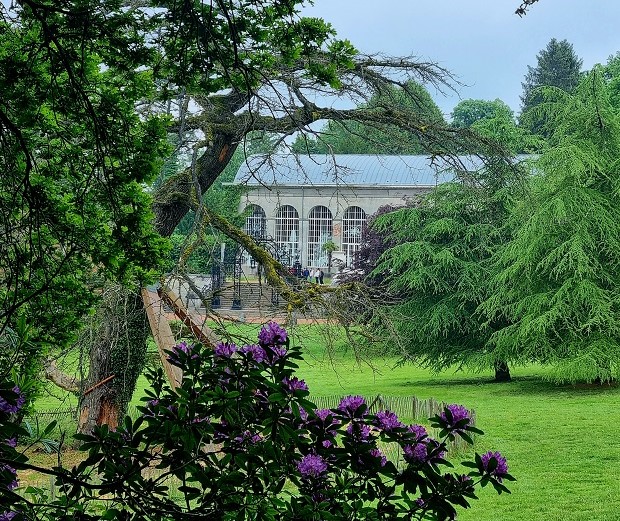
Illustrious history
Located near La Louvière in the province of Hainaut, this was once the region’s industrial heartland. It makes for an incongruous setting, but delving into the fascinating 500-year history of Mariemont reveals how the area was once a rural playground for a succession of European royals. The sister of Charles V, Mary of Hungary, first established a hunting lodge on the forested site in the 16th century. It was designed by celebrated Renaissance architect and sculptor Jacques du Broeucq from Mons.
Austrian archduke Albert and his wife Isabelle, equally fans of hunting, later transformed the lodge into a resplendent royal residence. Subsequent owners, including Louis XIV of France (the Sun King) and Charles of Lorraine, remodelled it into a sumptuous palace. But French Revolutionary forces burnt it almost to the ground with local pillaging responsible for its further destruction.
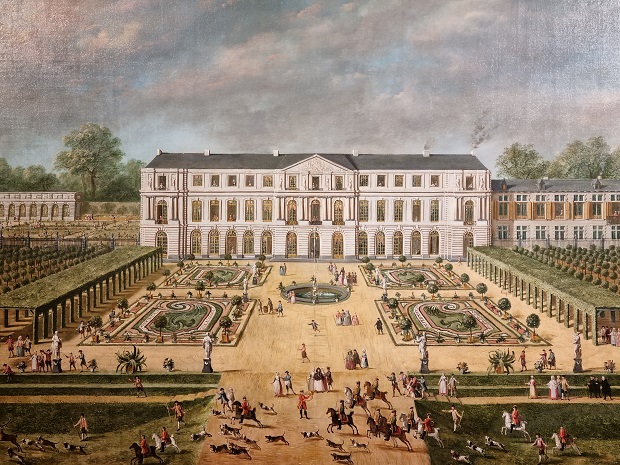
The domain was then bought by the wealthy Warocqué family, who exploited local mines. A stretch of neighbouring forest was acquired to build a new stately home. The last owner was Raoul Warocqué who bequeathed the domain to the Belgian state on his death in 1917 on condition that it opened for free to the public.
As well as being an illustrious figure in the region, the industrialist and politician had a passion for art. He collected masterpieces of classical antiquity, including rare frescoes from Pompeii, Greek and Roman statues, as well as fine Chinese and Japanese works and local collections. Fortunately, they survived a fire that destroyed the chateau in 1960.
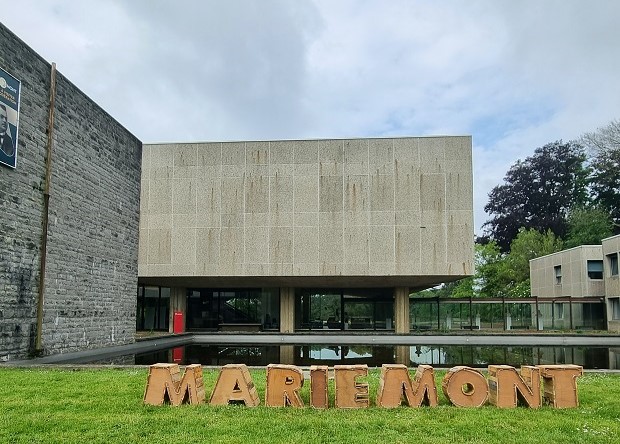
These exhibits are now housed in the Mariemont Museum, which was designed by Belgian architect Roger Bastin and opened in the 1970s. The brutalist concrete structure incorporates the one wing of the chateau that survived the blaze. Despite its modernism, the museum surprisingly blends unobtrusively into the surrounding parkland.
Winding paths, brightly-hued rhododendrons and azaleas, rare species of trees – it’s a tranquil oasis whatever the season. Ivy-strewn ruins from the former palace add a romantic air, along with an existing ‘mixed trail’ of sculptures by 19th and early 20th century artists. They include Meunier, Rousseaux, Lambeau and Devresse and Rodin, whose masterwork The Burgers of Calais is currently on loan to the city of Mons.
Marie’Art Trail
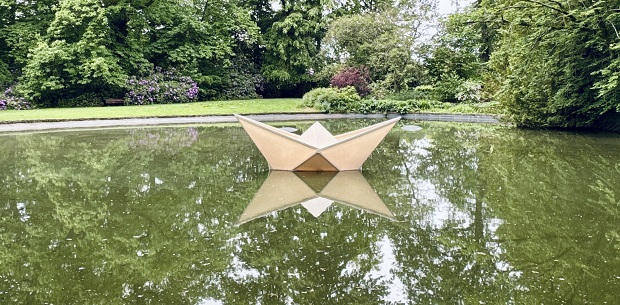
1 Ship without a Sea by Phayam Production – Marina Gutiérrez & Antoine Mathurin (Fr/Sp)
Inspired by the folded paper boats that have forever amused young children, this installation recalls the fragility and temporality of life. Gently drifting in the pond alongside the pathway between the main gates and the museum, it initially emerges from afar as if floating within the park. While playful and poetic, it’s also a reflection on the ecological impact of the scarcity of water and the ups and downs of life. As dark falls, the plucky little boat lights up for an additional magical effect.
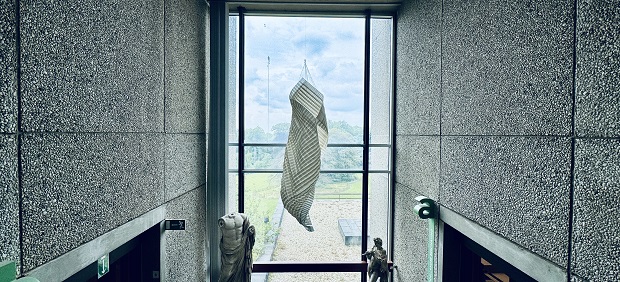
2 Liquid Time by Mieke Smet (Bel)
This suspended work of art is located inside the museum, inviting viewers to venture into the home of the prestigious collections. Hanging in the window of a lofty space on the first floor, it serves as a dialogue between the interior and the exterior, visible from the park below. Smet’s delicate work is crafted from paper originating from the museum archives. She employs her trademark technique of folding and sewing to create the shell-like structure. Both the recycling and chosen material are more than a nod to the surrounding trees and nature, they raise awareness about the importance of sustainability. The work’s title reflects the artists preoccupation with the passage of time and is deliberately open to interpretation.
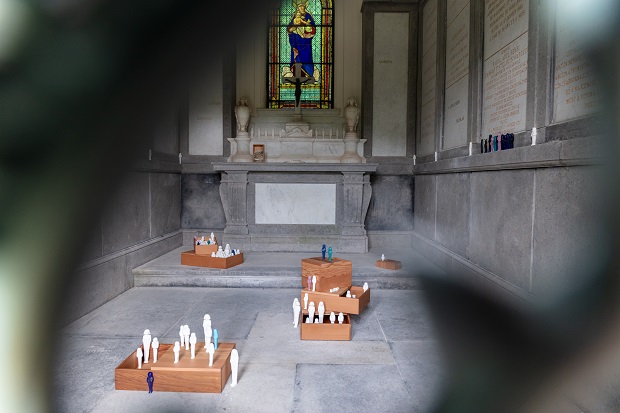
3 Servants of Identity by Myriam Louyest (Bel)
Sited in the Warocqué family mausoleum overlooking the rosary, some 200 moulded figurines portray the chaouabtis, the funerary statuettes that were placed in the tombs of the wealthy in ancient Egypt. Grouped within the closed and sacred interior of the temple, visitors view them via the intricately metal carved doorway. It’s a poignant sight; the small minimalist figures evoking both mortality and their position as social outcasts. By placing them in this highly-personal heritage site, Louyest dismantles social and economic hierarchies. The hand-crafted installation echoes the museum’s own collection of statues of domestics in its Egyptian section.
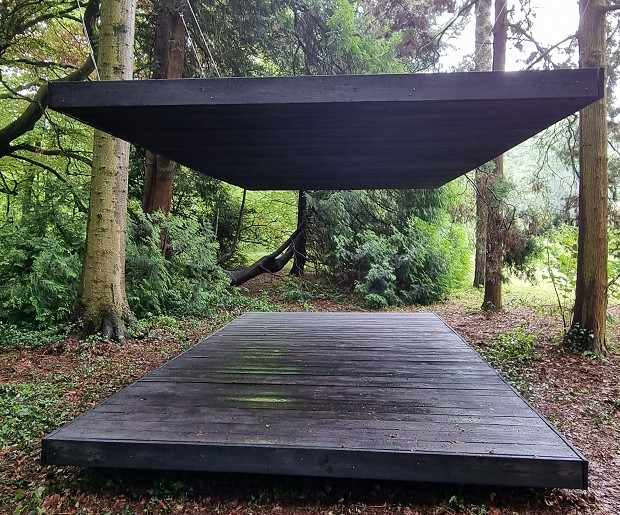 4 Forest Box by Abitalbero – Daniele del Grande (It)
4 Forest Box by Abitalbero – Daniele del Grande (It)
This immersive installation consists of two minimalist wooden platforms that form a room within the forest. One is raised just above the ground, the other elevated higher to create an open cabin which visitors are invited to step into for alternative views of the woodland, heritage trees and parkland. The interactive exhibit provides a framed vista which raises questions about how we occupy and relate to nature. Painted in black, the wooden plank structure is a window onto the world of Mariemont: a discreet installation that harks back to an era when the landed gentry sought out pavilions and other outdoor settings from which to admire their landscaped gardens.
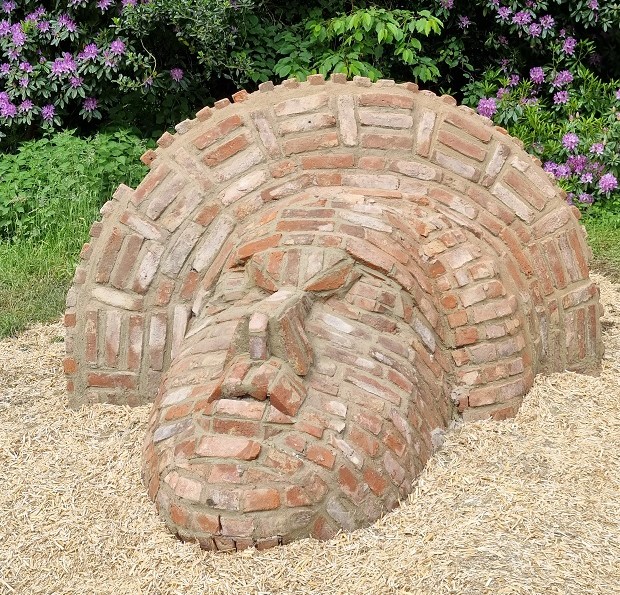
5 Mary of Hungary by Jérôme Malevez (Bel)
The domain’s founder Mary of Hungary served as inspiration for the artist and architect who was intrigued by her love of not only the arts but military defences. Recycled from orange-hued bricks originating from the estate’s crumbling walls, the exhibit evokes history, inheritance and power. Embedded into the ground, this sculpture is both integrated into the site and invoking its heritage. Malevez was also fascinated by the colossal statue of a Ptolemaic Queen in the museum’s Egyptian section. He made intricate preparatory sketches of the symbolic historical figure to create a memorial, which is also an amusing and irreverent tribute with its material of humble brick.
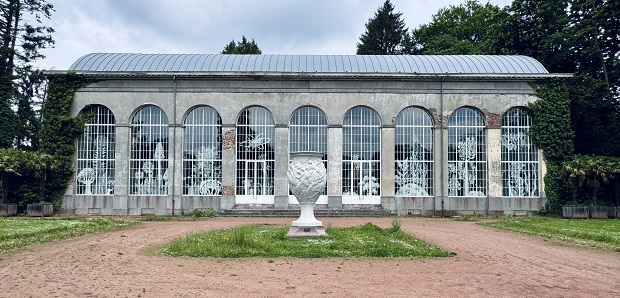
6 Plant Dys-Harmony by Chloé Coomans & Catho Hensmans (Bel)
The soaring arcades of the domain’s winter garden afford a temporary home to this installation of black and white sculpted drawings. It was constructed by the Warocqué family, in the style of the 18th century orangery that was once annexed to the former palace of Charles of Lorraine. The artist duo reimagined the flora that the 19th century building once housed with the installation purpose built to fill the nine south-facing arched windows. The disproportion of its jungle vegetation evokes the current imbalance of nature and ecology. Their monochrome palette also draws attention to the ecological challenges that the world faces.
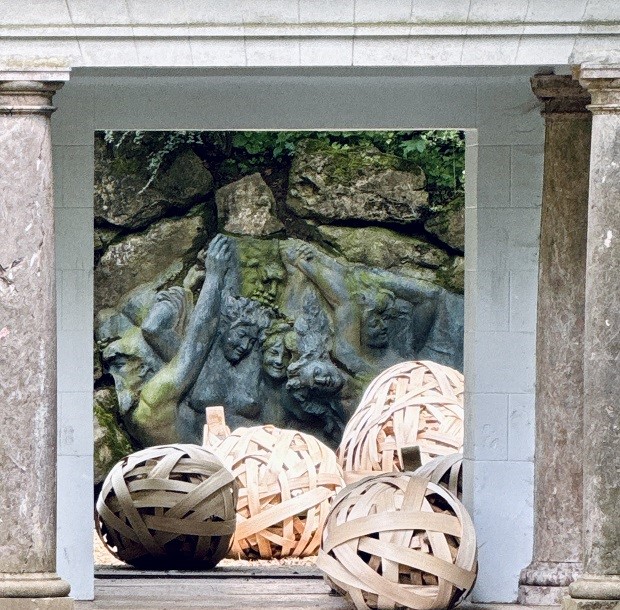
7 Exodus by Elparo (Fr)
In the shade of the secluded Roman baths, a group of strange creatures appear to be in motion between the two stretches of water. These large-scale amorphous ‘droplets’ have been fabricated out of woven wood containing wooden offcuts. While the installation presents a seemingly harmonious picture, it serves as an interrogation about water, the environment and migration. Again, the objects are open to all kinds of creative interpretation.
A final installation presents a collaborative work introduced by the passionate team at the museum. Let’s Twirl is created out of discarded plastic bottles; transparent curls suspended from the ground floor glass-windowed corridor. A workshop within the museum invites visitors to contribute to the collective installation.
Allow around 45 minutes to one hour for the trail, longer if you want to fully explore the park and the museum. Pick up a map (available in English) from the museum reception. A brasserie serves meals, drinks and snacks, with a terrace that provides an idyllic view of the verdant park.
Marie’Art
Until 22 September
Royal Domain of Mariemont
Chaussée de Morlanwelz 100
Morlanwelz (Hainaut)
Entrance to the park and the museum is free. Tickets are required for temporary exhibitions only.
Photos: (main image) Elparo ©BE CULTURE; Le château de Mariemont by J-B Simons, 1773 ©Sarah Crew; Phayam productions 2 ©BE CULTURE; Mieke Smet ©BE CULTURE; Myriam Louyest ©MRM; Abitalbero ©Sarah Crew; Jérôme Malevez ©Sarah Crew; Chloé Coomans & Catho Hensmans ©BE CULTURE; Elparo ©BE CULTURE

















